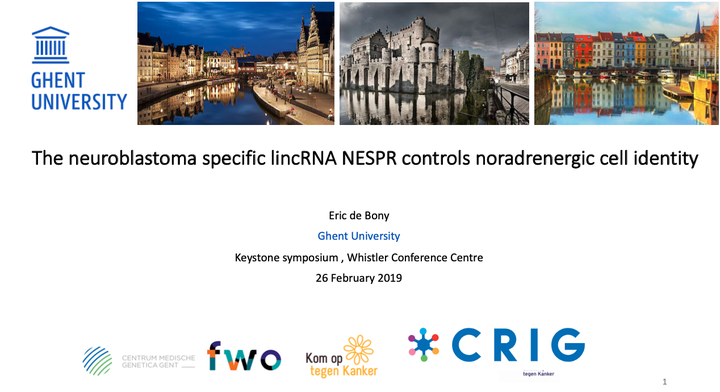The neuroblastoma specific lincRNA NESPR controls noradrenergic cell identity

Abstract
Neuroblastoma is one of the most enigmatic tumors, since clinical behavior ranges from spontaneous regression to metastatic disease refractory to aggressive multimodal therapy. In an attempt to study the involvement of lncRNAs in neuroblastomagenesis, we performed a pan-cancer lncRNA expression analysis comparing over 30 different tumor types. This resulted in the identification of the neuroblastoma-specific lncRNA NESPR (Figure 1). NESPR is located in the PHOX2B super-enhancer and, unlike many lncRNAs, NESPR is abundantly expressed, efficiently spliced and highly conserved in mammals. In neuroblastoma, high NESPR expression is associated with high stage disease, MYCN amplification and poor patient survival, suggesting NESPR may function as a lineage survival oncogene. To assess the function of NESPR in neuroblastoma, antisense oligonucleotides (ASOs) and siRNA pools (siPOOLs) were used to knock down its expression. While ASOs were capable of reducing both the nuclear and cytoplasmic fraction of NESPR, siPOOLs only reduced the cytoplasmic fraction. Notably, knockdown of the nuclear fraction, but not the cytoplasmic fraction, resulted in a significant decrease in colony formation and cell growth, as evidenced by cell viability assays and real-time cell monitoring. These effects were accompanied by an increase in apoptosis and were validated using independent ASO sequences. RNA-sequencing of ASO-treated neuroblastoma cell lines revealed a significant reduction of several neuroblastoma master regulators including PHOX2B, PHOX2A, DACH11 and ZNF536, indicating that NESPR may be involved in the core regulatory circuit that determines neuroblastoma cell identity (Figure 2). Using 4C-sequencing we could demonstrate a long-range interaction between the NESPR locus and the PHOX2B promoter (Figure 2), fitting the scenario/suggesting that the nuclear fraction of NESPR may act as a cis-regulator of PHOX2B expression. Overall these results have sparked our interest and have led us to device down-stream experiments (mechanistical and phenotypical) which will allow us to investigate the potential of NESPR has a therapeutic target and/or biomarker in neuroblastomas. Whether NESPR is driving chromatin looping remains to be determined. Preliminary results from a ChIRP-MS experiment (to identify NESPR binding partners through NESPR pull-down and mass spectrometry), demonstrate that NESPR interacts with multiple chromatin modifiers, suggesting it may assist recruitment of these factors.